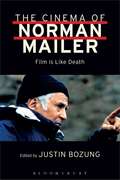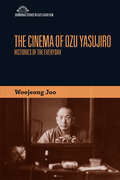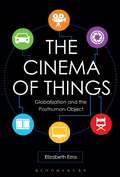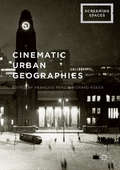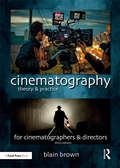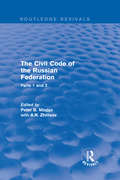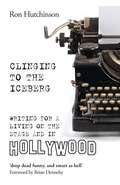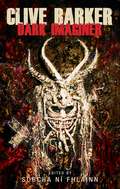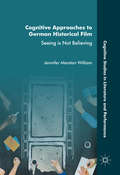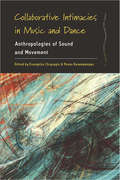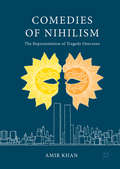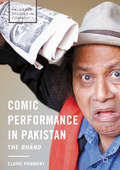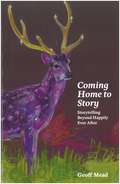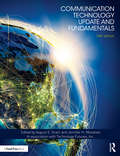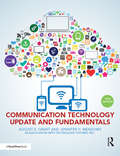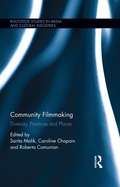- Table View
- List View
The Cinema of Norman Mailer: Film is Like Death
by Norman Mailer Justin BozungThe Cinema of Norman Mailer: Film is Like Death not only examines the enfant terrible writer's thoughts on cinema, but also features interviews with Norman Mailer himself. The Cinema of Norman Mailer also explores Mailer's cinema through previously published and newly commissioned essays written by an array of film and literary scholars, enthusiasts, and those with a personal, philosophical connection to Mailer. This volume discusses the National Book Award and Pulitzer Prize-winning author and filmmaker's six films created during the years of 1947 and 1987, and contends to show how Mailer's films can be best read as cinematic delineations that visually represent many of the writer's metaphysical and ontological concerns and ideas that appear in his texts from the 1950s until his passing in 2007. By re-examining Mailer's cinema through these new perspectives, one may be awarded not just a deeper understanding of Mailer's desire to make films, but also find a new, alternative vision of Mailer himself. Norman Mailer was not just a writer, but more: he was one of the most influential Postmodern artists of the twentieth century with deep roots in the cinema. He allowed the cinema to not only influence his aesthetic approach, but sanctioned it as his easiest-crafted analogy for exploring sociological imagination in his writing. Mailer once suggested, "Film is legitimately more interesting than books..." and with that in mind, readers of Norman Mailer might begin to rethink his oeuvre through the viewfinder of the film medium, as he was equally as passionate about working within cinema as he was about literature itself.
The Cinema of Ozu Yasujiro: Histories of the Everyday (Edinburgh Studies in East Asian Film)
by Woojeong JooOne of the most well regarded of non-Western film directors, responsible for acknowledged classics like Tokyo Story (1953), Ozu Yasujiro worked during a period of immense turbulence for Japan and its population. This book offers a new interpretation of Ozu’s career, from his earliest work in the 1920s up to his death in 1963, focusing on Ozu’s depiction of the everyday life and experiences of ordinary Japanese people during a time of depression, war and economic resurgence. Firmly situating him within the context of the Japanese film industry, Woojeong Joo examines Ozu’s work as a studio director and his relation to sound cinema, and looks in-depth at his wartime experiences and his adaptation to postwar Japanese society. Drawing on Japanese materials not previously examined in western scholarship, this is a groundbreaking new study of a master of cinema.
The Cinema of Ozu Yasujiro: Histories of the Everyday (Edinburgh Studies in East Asian Film)
by Woojeong JooOne of the most well regarded of non-Western film directors, responsible for acknowledged classics like Tokyo Story (1953), Ozu Yasujiro worked during a period of immense turbulence for Japan and its population. This book offers a new interpretation of Ozu’s career, from his earliest work in the 1920s up to his death in 1963, focusing on Ozu’s depiction of the everyday life and experiences of ordinary Japanese people during a time of depression, war and economic resurgence. Firmly situating him within the context of the Japanese film industry, Woojeong Joo examines Ozu’s work as a studio director and his relation to sound cinema, and looks in-depth at his wartime experiences and his adaptation to postwar Japanese society. Drawing on Japanese materials not previously examined in western scholarship, this is a groundbreaking new study of a master of cinema.
The Cinema of Things: Globalization and the Posthuman Object
by Elizabeth EzraThis book explores the border zones between life and non-life as represented in cinema from the end of the nineteenth century, when France led the global film industry, to the first decades of the twenty-first century, when world film markets are dominated by Hollywood. Informed by both the Internet of Things and the Parliament of Things, The Cinema of Things examines cinematic depictions of the ways in which human beings are prosthetically engaged with life beyond the self in the global age: by hyperconsumption; by structures of racial and sexual objectification that reduce people designated as "others†? to objects of fascination, sexual gratification, warfare, or labor; and by information technology that replaces human agency with encoding. Consumer culture, a key feature of globalization, posits that we must supplement ourselves with commodities without which we would otherwise be incomplete: but these prostheses, rather than enhancing us, end up creating the insufficiencies they were meant to overcome. We are engulfed by objects, to the extent that we ourselves are becoming objectified. At the same time, objects, especially technological objects, are becoming increasingly autonomous, assuming roles that were once the preserve of human agency. We are becoming the objects of globalization, and cinema imaginatively represents this transformation, but it also offers us the possibility of retaining our humanity in the process.
The Cinema of Things: Globalization and the Posthuman Object
by Elizabeth EzraThis book explores the border zones between life and non-life as represented in cinema from the end of the nineteenth century, when France led the global film industry, to the first decades of the twenty-first century, when world film markets are dominated by Hollywood. Informed by both the Internet of Things and the Parliament of Things, The Cinema of Things examines cinematic depictions of the ways in which human beings are prosthetically engaged with life beyond the self in the global age: by hyperconsumption; by structures of racial and sexual objectification that reduce people designated as “others” to objects of fascination, sexual gratification, warfare, or labor; and by information technology that replaces human agency with encoding. Consumer culture, a key feature of globalization, posits that we must supplement ourselves with commodities without which we would otherwise be incomplete: but these prostheses, rather than enhancing us, end up creating the insufficiencies they were meant to overcome. We are engulfed by objects, to the extent that we ourselves are becoming objectified. At the same time, objects, especially technological objects, are becoming increasingly autonomous, assuming roles that were once the preserve of human agency. We are becoming the objects of globalization, and cinema imaginatively represents this transformation, but it also offers us the possibility of retaining our humanity in the process.
Cinematic Urban Geographies (Screening Spaces)
by Richard Koeck François PenzThis book proposes new methodological tools and approaches in order to tease out and elicit the different facets of urban fragmentation through the medium of cinema and the moving image, as a contribution to our understanding of cities and their topographies. In doing so it makes a significant contribution to the literature in the growing field of cartographic cinema and urban cinematics, by charting the many trajectories and points of contact between film and its topographical context. Under the influence of new technologies, the opening and the availability of previously unexplored archives but also the contribution of new scholars with novel approaches in addition to new work by experienced academics, Cinematic Urban Geographies demonstrates how we can reread the cinematic past with a view to construct the urban present and anticipate its future.
Cinematography: Image Making for Cinematographers and Directors
by Blain BrownThe world of cinematography has changed more in the last few years than it has since it has in 1929, when sound recording was introduced. New technology, new tools and new methods have revolutionized the art and craft of telling stories visually. While some aspects of visual language, lighting and color are eternal, shooting methods, workflow and cameras have changed radically. Even experienced film artists have a need to update and review new methods and equipment. These change affect not only the director of photography but also the director, the camera assistants, gaffers, and digital imaging technicians. Cinematography: Theory and Practice covers both the artistry and craftsmanship of cinematography and visual storytelling. Few art forms are as tied to their tools and technology as is cinematography. Take your mastery of these new tools, techniques, and roles to the next level with this cutting-edge roadmap from author and filmmaker Blain Brown. Whether you are a student of filmmaking, just breaking into the business, currently working in the industry and looking to move up to the next level, or an experienced professional who wants to update their knowledge of tools and techniques, this book provides both a basic introduction to these issues as well as more advanced and in-depth coverage of the subject. The companion website features additional material, including lighting demonstrations, basic methods of lighting, using diffusion and other topics. Topics Include: Visual language Visual storytelling Continuity and coverage Cameras and digital sensors Exposure techniques for film and video Color in-depth Understanding digital images Waveform monitors, vectorscopes, and test charts Using linear, gamma, and log encoded video Image control and grading on the set The tools and basics of film lighting ASC-CDL, ACES and other new methods Optics and focus Camera movement Set operations Green screen, high speed and other topics
Cinematography: Image Making for Cinematographers and Directors
by Blain BrownThe world of cinematography has changed more in the last few years than it has since it has in 1929, when sound recording was introduced. New technology, new tools and new methods have revolutionized the art and craft of telling stories visually. While some aspects of visual language, lighting and color are eternal, shooting methods, workflow and cameras have changed radically. Even experienced film artists have a need to update and review new methods and equipment. These change affect not only the director of photography but also the director, the camera assistants, gaffers, and digital imaging technicians. Cinematography: Theory and Practice covers both the artistry and craftsmanship of cinematography and visual storytelling. Few art forms are as tied to their tools and technology as is cinematography. Take your mastery of these new tools, techniques, and roles to the next level with this cutting-edge roadmap from author and filmmaker Blain Brown. Whether you are a student of filmmaking, just breaking into the business, currently working in the industry and looking to move up to the next level, or an experienced professional who wants to update their knowledge of tools and techniques, this book provides both a basic introduction to these issues as well as more advanced and in-depth coverage of the subject. The companion website features additional material, including lighting demonstrations, basic methods of lighting, using diffusion and other topics. Topics Include: Visual language Visual storytelling Continuity and coverage Cameras and digital sensors Exposure techniques for film and video Color in-depth Understanding digital images Waveform monitors, vectorscopes, and test charts Using linear, gamma, and log encoded video Image control and grading on the set The tools and basics of film lighting ASC-CDL, ACES and other new methods Optics and focus Camera movement Set operations Green screen, high speed and other topics
The Civil Code of the Russian Federation: Parts 1 and 2 (Routledge Revivals)
by Peter B MaggsThis title was first published in 1997: This is the definitive English translation of the new Russian Civil Code (Parts 1 and 2), often referred to as "the second Russian Constitution". The Civil Code of the Russian Federation is the result of a collaborative effort of a leading United States expert on Russian law and of the staff of the Private Law Research Center attached to the Office of the President of the Russian Federation -- the Center that had primary responsibility for drafting the new Civil Code. The authoritative introduction, complete table of contents. and comprehensive index combine to set this work far beyond the utility of any existing translations of the Civil Code. It will be a must-have resource for government, law and international business collections.
The Civil Code of the Russian Federation: Parts 1 and 2 (Routledge Revivals)
by Peter B MaggsThis title was first published in 1997: This is the definitive English translation of the new Russian Civil Code (Parts 1 and 2), often referred to as "the second Russian Constitution". The Civil Code of the Russian Federation is the result of a collaborative effort of a leading United States expert on Russian law and of the staff of the Private Law Research Center attached to the Office of the President of the Russian Federation -- the Center that had primary responsibility for drafting the new Civil Code. The authoritative introduction, complete table of contents. and comprehensive index combine to set this work far beyond the utility of any existing translations of the Civil Code. It will be a must-have resource for government, law and international business collections.
Clinging to the Iceberg: Writing for a Living on the Stage and in Hollywood (Oberon Books)
by Ron HutchinsonWickedly funny, insightful, often absurd but always true, Clinging to the Iceberg explores the inner workings of the business of writing for hire. It’s written by someone whose career has spanned over forty years on stage and on screen, including thirty lucrative and sometimes uproarious ones in Hollywood. Genuinely laugh-out-loud, it will astound and inspire and along the way reveal the REAL tricks of the dialogue writers’ trade.Hutchinson takes us through his successful career via hilarious anecdotes including a near-death experience on Venice Beach, being paid by Dreamworks to not actually work for them, and struggling to stay sane on location on one of the great movie flops of all time.
Clive Barker: Dark imaginer
by Sorcha Ní FhlainnA necessary and timely study of Barker’s influence in dark fantasy, gothic and horror studies. The book features twelve groundbreaking essays on Barker’s creative legacy and influence, and reevaluates his celebrated and lesser known works in fiction, film and visual art, from the Books of Blood (1984–85) to The Scarlet Gospels (2015).
Clive Barker: Dark imaginer
by Sorcha Ní FhlainnClive Barker: Dark imaginer explores the diverse literary, film and visionary creations of the polymathic and influential British artist Clive Barker. In this necessary and timely collection, innovative essays by leading scholars in the fields of literature, film and popular culture explore Barker’s contribution to gothic, fantasy and horror studies, interrogating his creative legacy. The volume consists of an extensive introduction and twelve groundbreaking essays that critically reevaluate Barker’s oeuvre. These include in-depth analyses of his celebrated and lesser known novels, short stories, theme park designs, screen and comic book adaptations, film direction and production, sketches and book illustrations, as well as responses to his material from critics and fan communities. Clive Barker: Dark imaginer reveals the breadth and depth of Barker’s distinctive dark vision, which continues to fascinate and flourish.
Cognitive Approaches to German Historical Film: Seeing is Not Believing
by Jennifer Marston WilliamThis book explores how minds at the movies understand minds in the movies and introduces readers to some fundamental principles of Cognitive Studies—namely conceptual blending, Theory of Mind, and empathy/perspective-taking—through their application to film analysis. A cognitive approach to recent popular historical films demonstrates cinema’s potential to stimulate viewers’ critical thinking about crucial events of the past century. Diverging from the focus on narrative processing in traditional cognitivist theory, this book examines film reception and production in the context of the latest developments in cognitive and social psychology. Turning to German cinema as a case study for this interdisciplinary partnership, Jennifer Marston William offers a fresh look at some internationally successful films of the twenty-first century, including Nowhere in Africa, Goodbye, Lenin!, Sophie Scholl, Downfall, The Lives of Others, and The Baader-Meinhof Complex.
Cognitive Approaches to German Historical Film: Seeing is Not Believing (PDF)
by Jennifer Marston WilliamThis book explores how minds at the movies understand minds in the movies and introduces readers to some fundamental principles of Cognitive Studies—namely conceptual blending, Theory of Mind, and empathy/perspective-taking—through their application to film analysis. A cognitive approach to recent popular historical films demonstrates cinema’s potential to stimulate viewers’ critical thinking about crucial events of the past century. Diverging from the focus on narrative processing in traditional cognitivist theory, this book examines film reception and production in the context of the latest developments in cognitive and social psychology. Turning to German cinema as a case study for this interdisciplinary partnership, Jennifer Marston William offers a fresh look at some internationally successful films of the twenty-first century, including Nowhere in Africa, Goodbye, Lenin!, Sophie Scholl, Downfall, The Lives of Others, and The Baader-Meinhof Complex.
Collaborative Intimacies in Music and Dance: Anthropologies of Sound and Movement (Dance and Performance Studies #10)
by Evangelos Chrysagis and Panas KarampampasAcross spatial, bodily, and ethical domains, music and dance both emerge from and give rise to intimate collaboration. This theoretically rich collection takes an ethnographic approach to understanding the collective dimension of sound and movement in everyday life, drawing on genres and practices in contexts as diverse as Japanese shakuhachi playing, Peruvian huayno, and the Greek goth scene. Highlighting the sheer physicality of the ethnographic encounter, as well as the forms of sociality that gradually emerge between self and other, each contribution demonstrates how dance and music open up pathways and give shape to life trajectories that are neither predetermined nor teleological, but generative.
Comedies of Nihilism: The Representation of Tragedy Onscreen
by Amir KhanThis book presents close-readings of seven post-millennial comedic films: Up in the Air, Tropic Thunder, JCVD, Winnebago Man, The Trotsky, Be Kind Rewind, and Hamlet 2. It is a sequel to Stanley Cavell’s 1981 landmark study of the comedic genre, Pursuits of Happiness, where he examines seven comedies of Hollywood’s “Golden Age.” Khan puts forward the idea that comedies, once centred on the conventional “happy ending,” are no longer interested in detailing the steps to any ending we might call happy. Instead, the agenda of most culturally serious comedies today is to “spoof,” to make all that is fair foul. The seven films presented here risk a type of cultural nihilism—spoofing for the sake of spoofing and nothing else, indicative not of film’s promise but its failure. By equating the failure of film with the failed national politics of Canada (or the failed politics of nationalism and community more generally), this study shows that comedy has less to do with happiness and more to do with the grotesque. The films analysed represent hyper-realized forms of comic irony and move towards what theatre knows as tragedy, or a tragic vision.
Comedies of Nihilism: The Representation of Tragedy Onscreen
by Amir KhanThis book presents close-readings of seven post-millennial comedic films: Up in the Air, Tropic Thunder, JCVD, Winnebago Man, The Trotsky, Be Kind Rewind, and Hamlet 2. It is a sequel to Stanley Cavell’s 1981 landmark study of the comedic genre, Pursuits of Happiness, where he examines seven comedies of Hollywood’s “Golden Age.” Khan puts forward the idea that comedies, once centred on the conventional “happy ending,” are no longer interested in detailing the steps to any ending we might call happy. Instead, the agenda of most culturally serious comedies today is to “spoof,” to make all that is fair foul. The seven films presented here risk a type of cultural nihilism—spoofing for the sake of spoofing and nothing else, indicative not of film’s promise but its failure. By equating the failure of film with the failed national politics of Canada (or the failed politics of nationalism and community more generally), this study shows that comedy has less to do with happiness and more to do with the grotesque. The films analysed represent hyper-realized forms of comic irony and move towards what theatre knows as tragedy, or a tragic vision.
Comic Performance in Pakistan: The Bhānd (Palgrave Studies in Comedy)
by Claire PammentThis book explores comic performance in Pakistan through the vibrant Indo-Muslim tradition of the Punjabi bhānd which now holds a marginal space in contemporary weddings. With irreverent repartee, genealogical prowess, a topsy-turvy play with hierarchies and shape shifting, the low-status bhānd jostles space in otherwise rigid class and caste hierarchies. Tracing these negotiations in both historical and contemporary sites, the author unfolds a dynamic performance mode that travels from the Sanskrit jester and Sufi wise fool, into Muslim royal courts and households, weddings, contemporary carnivalesque and erotic popular Punjabi theatre and satellite television news. Through original historical and ethnographic research, this book brings to life hitherto unexplored territories of Pakistani popular culture and Indo-Muslim performance histories.
Coming Home to Story: Storytelling Beyond Happily Ever After
by Geoff MeadStories take us into other worlds so that we may experience our own more deeply. Master storyteller Geoff Mead brings the reader inside the experience of telling and listening to a story. He shows how stories and storytelling engage our imaginations, strengthen communities and bring adventure and joy into our lives. The narrative is interspersed with consummate retellings of traditional tales from all over the world.
Communication Technology Update and Fundamentals: 16th Edition
by August E. Grant Jennifer H. MeadowsFor three decades, Communication Technology Update and Fundamentals has set the standard as the single best resource for students and professionals looking to brush up on how communication technologies have developed, grown, and converged, as well as what’s in store for the future. The secret to the longevity is simple—every two years, the book is completely rewritten to ensure that it contains the latest developments in mass media, computers, consumer electronics, networking, and telephony. Plus, the book includes the Fundamentals: the first five chapters explain the communication technology ecosystem, the history, structure, and regulations. The chapters are written by experts who provide snapshots of the state of each individual field. Together, these updates provide a broad overview of these industries, as well as the role communication technologies play in our everyday lives. In addition to substantial updates to each chapter, the 16th edition includes: First-ever chapters on Virtual/Augmented Reality and eSports. Updated user data in every chapter. Overview of industry structure, including recent and proposed mergers and acquisitions Suggestions on how to get a job working with the technologies discussed. The companion website, www.tfi.com/ctu, offers updated information on the technologies covered in this text, as well as links to other resources.
Communication Technology Update and Fundamentals: 15th Edition
by August E. Grant Jennifer H. MeadowsCommunication Technology Update and Fundamentals has set the standard as the single best resource for students and professionals looking to brush up on how communication technologies have developed, grown, and converged, as well as what’s in store for the future. The 15th edition is completely updated, reflecting the changes that have swept the communication industries. The first five chapters offer the communication technology fundamentals, including the ecosystem, the history, and structure—then delves into each of about two dozen technologies, including mass media, computers, consumer electronics, and networking technologies. Each chapter is written by experts who provide snapshots of the state of each individual field. Together, these updates provide a broad overview of these industries, as well as the role communication technologies play in our everyday lives. In addition to substantial updates to each chapter, the 15th edition includes: First-ever chapters on Big Data and the Internet of Things Updated user data in every chapter Projections of what each technology will become by 2031 Suggestions on how to get a job working with the technologies discussed The companion website, www.tfi.com/ctu, offers updated information on the technologies covered in this text, as well as links to other resources
Communication Technology Update and Fundamentals: 15th Edition
by August E. Grant Jennifer H. MeadowsCommunication Technology Update and Fundamentals has set the standard as the single best resource for students and professionals looking to brush up on how communication technologies have developed, grown, and converged, as well as what’s in store for the future. The 15th edition is completely updated, reflecting the changes that have swept the communication industries. The first five chapters offer the communication technology fundamentals, including the ecosystem, the history, and structure—then delves into each of about two dozen technologies, including mass media, computers, consumer electronics, and networking technologies. Each chapter is written by experts who provide snapshots of the state of each individual field. Together, these updates provide a broad overview of these industries, as well as the role communication technologies play in our everyday lives. In addition to substantial updates to each chapter, the 15th edition includes: First-ever chapters on Big Data and the Internet of Things Updated user data in every chapter Projections of what each technology will become by 2031 Suggestions on how to get a job working with the technologies discussed The companion website, www.tfi.com/ctu, offers updated information on the technologies covered in this text, as well as links to other resources
Communication Technology Update and Fundamentals: 16th Edition
by August E. Grant Jennifer H. MeadowsFor three decades, Communication Technology Update and Fundamentals has set the standard as the single best resource for students and professionals looking to brush up on how communication technologies have developed, grown, and converged, as well as what’s in store for the future. The secret to the longevity is simple—every two years, the book is completely rewritten to ensure that it contains the latest developments in mass media, computers, consumer electronics, networking, and telephony. Plus, the book includes the Fundamentals: the first five chapters explain the communication technology ecosystem, the history, structure, and regulations. The chapters are written by experts who provide snapshots of the state of each individual field. Together, these updates provide a broad overview of these industries, as well as the role communication technologies play in our everyday lives. In addition to substantial updates to each chapter, the 16th edition includes: First-ever chapters on Virtual/Augmented Reality and eSports. Updated user data in every chapter. Overview of industry structure, including recent and proposed mergers and acquisitions Suggestions on how to get a job working with the technologies discussed. The companion website, www.tfi.com/ctu, offers updated information on the technologies covered in this text, as well as links to other resources.
Community Filmmaking: Diversity, Practices and Places (Routledge Studies in Media and Cultural Industries)
by Sarita Malik Caroline Chapain Roberta ComunianThis book examines the role of community filmmaking in society and its connection with issues of cultural diversity, innovation, policy and practice in various places. Deploying a range of examples from Europe, North America, Australia and Hong Kong, the chapters show that film emerging from outside the mainstream film industries and within community contexts can lead to innovation in terms of both content and processes and a better representation of the cultural diversity of a range of communities and places. The book aims to situate the community filmmaker as the central node in the complex network of relationships between diverse communities, funding bodies, policy and the film industries.
